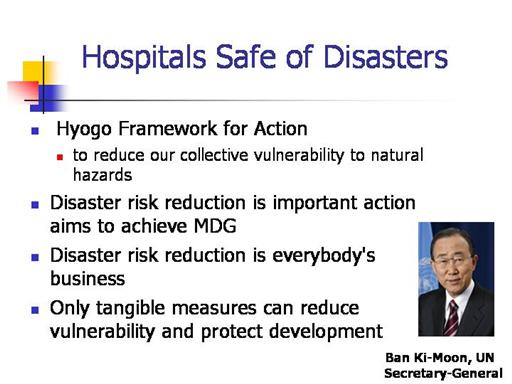| front |1 |2 |3 |4 |5 |6 |7 |8 |9 |10 |11 |12 |13 |14 |15 |16 |17 |18 |19 |20 |21 |22 |23 |24 |25 |review |
 |
The 168 countries that adopted the
Hyogo Framework for Action 2005-2015 recognized the importance of
“making hospitals safe from disasters by ensuring that all new hospitals
are built with a level of resilience that strengthens their capacity to
remain functional in disaster situations and implement mitigation
measures to reinforce existing health facilities, particularly those
providing primary health care”
The Hyogo Framework for Action
2005-2015 (HFA) included the following measure of commitment to and
success of disaster risk reduction:
• Integrate disaster risk reduction planning into the
health sector;
•- promote the goal of “hospitals
safe from disasters” by ensuring that all new hospitals are built with a level of
resilience that
strengthens their capacity to remain
functional in disaster situations
•- implement mitigation measures to
reinforce existing health facilities, particularly those providing
primary health care.
Following the campaign, it is
expected that a large number of governments will have developed
strategic action plans to ensure that hospitals and health facilities
will be made safe from disasters and that disaster risk reduction will
be an integral component of health policies
This joint global campaign was
started on January 25, 2008 in Davos, Switzerland. This global campaign
is organized by the UN International Strategy for Disaster Reduction
(UN/ISDR) and WHO, with support from the World Bank. It is a part of the
two years Global Disaster Reduction Campaign launched by UN
International Strategy for Disaster Reduction (from January, 2008 to
December, 2009) and it’s a one of the main tool for facilitating of
achievement of the of Hyogo
Framework for Action, by 2015.
Disaster risk reduction is
everybody’s business. Only by investing in tangible risk reduction
measures can we reduce vulnerability and protect development. This year
campaign is focused on the natural disasters and safety of hospitals.
Other important issues like
hospital infection, patient safety, medical errors or capacity to cope
with epidemics are not subject of this campaign although it doesn’t mean
that they are less important for the people’s health.
|